An alkene (A)C16H16 on ozonolysis gives only one product (B)(C8H8O). Compound (B) on reaction with NH2OH followed by reaction with H2SO4,Δ gives N - methyl benzamide the compound 'A' is -

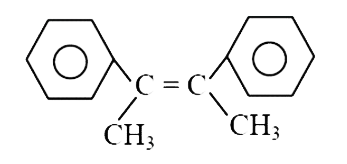


The correct Answer is:B
To determine the compound (A) from the given information, we will follow these steps:
Step 1: Analyze the information given
We know that compound (A) is an alkene with the formula C16H16. Upon ozonolysis, it yields compound (B) with the formula C8H8O. Compound (B) further reacts with hydroxylamine (NH2OH) and then with sulfuric acid (H2SO4) to produce N-methyl benzamide.
Step 2: Calculate the degree of unsaturation for compound (B)
The degree of unsaturation (DU) can be calculated using the formula:
DU=2C+2−H2
For compound (B) C8H8O:
- C=8
- H=8
Substituting the values:
DU=2(8)+2−82=16+2−82=102=5
This indicates that compound (B) has 5 degrees of unsaturation.
Step 3: Identify the structure of compound (B)
Given that compound (B) has a degree of unsaturation of 5, it likely contains a benzene ring (which accounts for 1 degree of unsaturation) and additional double bonds. Since it has a total of 8 carbon atoms, we can assume that it has a structure that includes a benzene ring and additional carbon atoms with double bonds.
Step 4: Determine the structure of compound (B)
The structure of compound (B) can be deduced as follows:
- The benzene ring contributes 6 carbons.
- The remaining 2 carbons can be connected through a double bond, leading to a structure like acetophenone (C6H5COCH3).
Step 5: Confirm the reaction to N-methyl benzamide
When compound (B) (assumed to be acetophenone) reacts with hydroxylamine, it forms an oxime. Upon heating with sulfuric acid, this oxime can rearrange to form N-methyl benzamide.
Step 6: Determine the structure of compound (A)
Since compound (A) is an alkene that yields two equivalents of compound (B) upon ozonolysis, we can deduce that compound (A) must be a symmetrical alkene that can break down into two molecules of acetophenone. The likely structure for compound (A) is:
(C6H5)2C=C(C6H5)
This structure consists of two phenyl groups attached to a double bond.
Final Answer
The compound (A) is:
1,2-Diphenylethylene (or stilbene)
---
We know that compound (A) is an alkene with the formula C16H16. Upon ozonolysis, it yields compound (B) with the formula C8H8O. Compound (B) further reacts with hydroxylamine (NH2OH) and then with sulfuric acid (H2SO4) to produce N-methyl benzamide.
The degree of unsaturation (DU) can be calculated using the formula:
DU=2C+2−H2
For compound (B) C8H8O:
- C=8
- H=8
DU=2(8)+2−82=16+2−82=102=5
This indicates that compound (B) has 5 degrees of unsaturation.
Given that compound (B) has a degree of unsaturation of 5, it likely contains a benzene ring (which accounts for 1 degree of unsaturation) and additional double bonds. Since it has a total of 8 carbon atoms, we can assume that it has a structure that includes a benzene ring and additional carbon atoms with double bonds.
The structure of compound (B) can be deduced as follows:
- The benzene ring contributes 6 carbons.
- The remaining 2 carbons can be connected through a double bond, leading to a structure like acetophenone (C6H5COCH3).
When compound (B) (assumed to be acetophenone) reacts with hydroxylamine, it forms an oxime. Upon heating with sulfuric acid, this oxime can rearrange to form N-methyl benzamide.
Since compound (A) is an alkene that yields two equivalents of compound (B) upon ozonolysis, we can deduce that compound (A) must be a symmetrical alkene that can break down into two molecules of acetophenone. The likely structure for compound (A) is:
(C6H5)2C=C(C6H5)
This structure consists of two phenyl groups attached to a double bond.
The compound (A) is:
1,2-Diphenylethylene (or stilbene)
Similar Questions
An organic compound (A),C8H4O3 in dry benzene in the presene of anhydorus AlCl3 gives compound (B). Compound (B) on treatment with PCl5 followed by reaction with H2/Pd(BaSO4) gives compound (C) which on reaction with hydrazine gives a cyclised compound (D),(C14H10N2) Idenyify (A),(B),(C) and (D). Explain the formation of (D) from (C).
View SolutionAn organic compound X(C5H10) on ozonolysis gives Y & Z. The product mixture Y and Z on reaction with NH2−OH gives four oximes.The structure of X is
View Solution
Knowledge Check
Compound (A) C8H6O2 on treatment with aq. NaOH followed by acidification gives (B) C3H2O3 which on oxidation gives benzoic acid only:
A B
B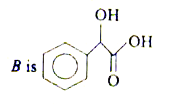 C
C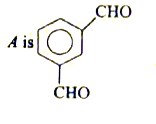 D
D
A compound (A) C5H10Cl2 on hydrolysis gives C5H10O which reacts with NH2OH, forms iodoform but does not give Fehling test (A) is :
AH3C−CI∣C∣CI−CH2CH2CH3BCH3CH2−CI∣C∣CI−CH2CH3CCI∣C∣CIHCH2CH2CH2CH3DCH3CH2CI∣CH−CI∣CHCH3
Compound (x)(m.f=C7H8N), on reaction with NaNO2 and conc. HCl at O∘C followed by β− naphthol gives orange coloured dye. Compound (x) is :
View SolutionAn organic compound with molecular formula C6H12 upon ozonolysis gives only acetone as the product. The compound is :
View SolutionA hydrocarbon 'A' (C4H8) on reaction HCl gives a compound 'B', (C4H9Cl) which on reaction with 1 mol of NH3 gives compounds 'C' (C4H11N). On reacting with NaNO2 and HCl followed by treatment with water compound 'C' yields an optically active alcohol, 'D'. Ozonolysis of 'A' given 2mols of acetyldehyde. Identify compound 'A' to 'D'. Explain the reaction involved.
View SolutionGive the products of the reaction with conc. H2SO4 of :
a.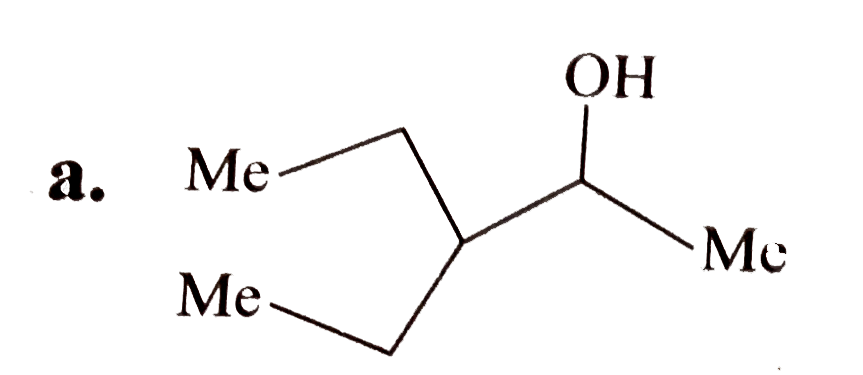
b.
c.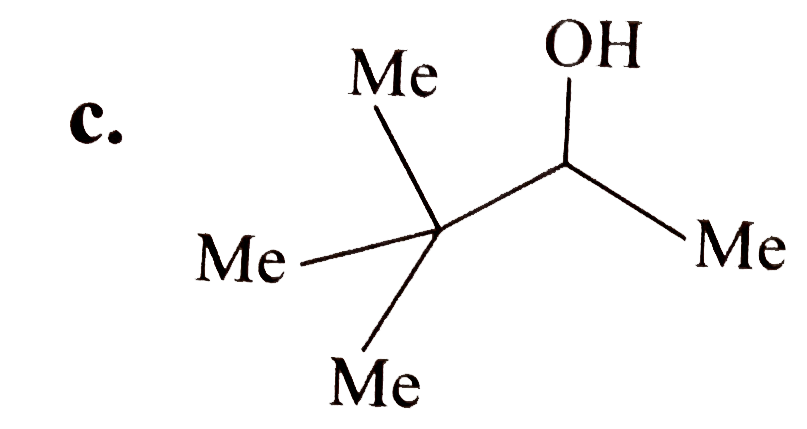
d. 1- Methyl cyclohexanol
View SolutionCompound (A)(C8H12) on oxidation gives an acid B(C4H6O2). One mole of compound (A) reacts with 3mol of H2 in the presence of Pt catalyst to give octane. Identify compound (A).
View SolutionA compound 'X' on ozonolysis followed by reduction gives an aldehyde, C2H4O and 2-butanone. Compound 'X' is:
View Solution
